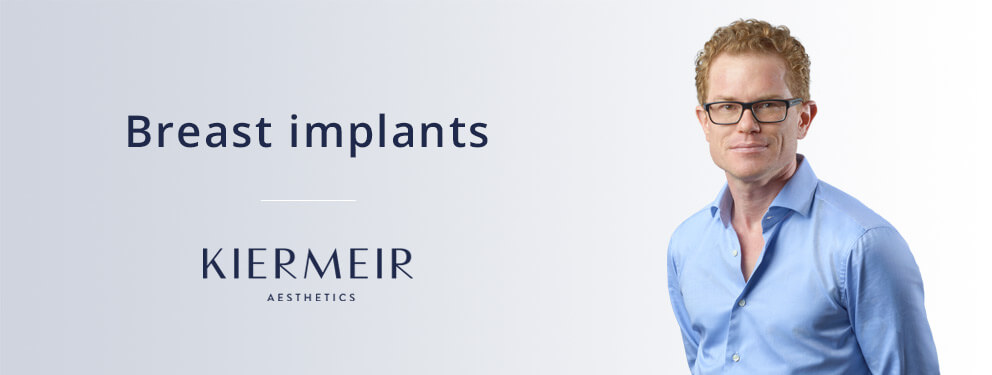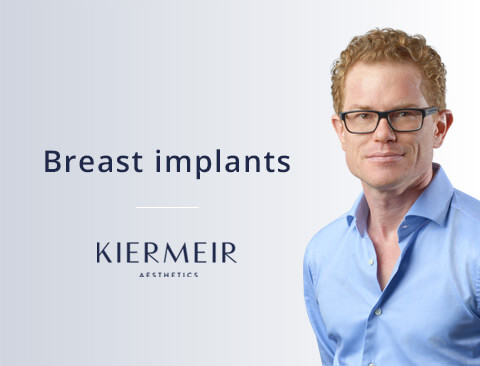Breast implants in Bern

Dr. med. David Kiermeir
Specialist for plastic, reconstructive and aesthetic surgery (FMH)
more than 15 years of surgical experience
since 12 years exclusively active in the field of plastic and aesthetic surgery
over 6,000 performed surgeries
Facts on breast implants
| Implant models: | round implants, anatomical implants |
| Implant size: | depending on individual conditions |
| Implant shell: | smooth or roughened surface structure |
| Implant filling: | sodium chloride or silicone |
Every woman is unique and has her own personal wishes. Accordingly, we have a wide range of breast implants for patients to choose from. Breast implants are composed of a silicone casing filled with either silicone gel or a saline solution. They can be round or ‘anatomical’ in shape, with either a smooth or textured (rough) surface, and are available in a whole host of shapes and sizes. This array of options makes it possible to achieve your desired results. In a personal consultation here in Bern, we’ll explain precisely what breast implants involve and support you in selecting the right model for you.
Various factors need to be considered when selecting a suitable implant, including:
Implant shape
It’s crucial that we give your breasts the desired shape – something that selecting the right implant can achieve. In addition to round models, we also offer anatomical or teardrop-shaped implants that more closely mimic the natural shape of a breast.
Round implants
Generally speaking, round implants make breasts appear fuller and plumper from every angle. They make a woman’s bust rounder and render her décolleté tauter. Round breast implants are the most common choice as they’re more affordable and feature a lower incidence of complications. The downside of round implants, however, is that the results can sometimes appear somewhat artificial as they give the breasts a consistent volume throughout. However, they can also achieve the desired effect and appear entirely ‘presentable’.
For some surgeons, it’s of no consequence whether you choose round or teardrop-shaped implants, as all models – regardless of their original shape – become somewhat rounded over time. Conversely, round implants even take on an anatomical shape when in position, as the filling material (or, to be precise, its mass centre) sinks downwards. This creates a more natural impression, particularly when the woman lies on her back.
What’s more, an implant plays less of a role in determining the shape of a woman’s bust if her breasts were already at least as big as the inserted implant. In this case, the implants barely affect the breasts’ shape, if at all. This means that, if the patient has good quality breast tissue or well-sized breasts, the implants’ shape is less important and round models can be used without the risk that they’ll distort the shape of the breast.
Anatomical implants
These implants, which are shaped like teardrops, were developed to reflect the profile of a natural breast with greater volume in the lower part of the breast.
While the upper part of an anatomical implant is very narrow, it gradually widens further down. This shape makes it possible to achieve extremely natural-looking results as the implants mimic the natural shape of a breast, blending extremely well with a typical feminine silhouette.
Anatomical implants vary in three dimensions: their width, height and projection depth. This means that a breast augmentation procedure can also effectively compensate for any imbalances in the size and shape of a woman’s breasts.
If, for example, the existing bust is rather wider than it is tall, the implant’s shape should also mirror this feature – or else the upper edge of the implant could become visible.
Conversely, implants used to augment a slimmer bust should also be slim, as the side edges of the implant would otherwise be evident. This also makes it possible to compensate for breasts of different sizes by using implants of different heights. As the two implants will only differ in terms of their height (projection) but feature identical vertical and horizontal diameters, the surgery’s results will appear natural and inconspicuous.
This flexibility to balance out shapes and asymmetries is one of the greatest advantages of anatomical implants.
However, anatomical implants also have certain drawbacks. For one, due to their shape they have a tendency to twist and become distorted, which can create an artificial appearance. This would require a further surgical procedure to correct the problem. The risk of distortion often depends on how the pouch of tissue to insert the implant was created during the operation. There are ways to counteract this, such as using breast implants with a textured casing that makes it harder for the implant to slip out of position. What’s more, anatomical implants are considerably more expensive than round implants – and it’s not always entirely clear whether they produce better results.
In summary: although anatomical implants might seem an obvious choice at first, they’re actually not as widely used as you might think. This may be due not only to their higher cost, but also to the fact that a more rounded breast is often closer to the patient’s desired result than a completely natural shape.
Size and volume
In addition to the implants’ shape, their size and volume is also a key aspect to consider in order to create the desired appearance. An important factor when comparing different implant manufacturers is the size of their product portfolio. Through our collaboration with one of the world’s leading implant manufacturers, Allergan, we’re able to offer our patients a broad spectrum of implants in various sizes and weights, making it possible to select implants to suit an individual’s specific requirements.
It’s important that you discuss your vision of the results with us so that we can take your expectations into account when selecting an appropriate size and shape.
The desired size of the implant is, in some cases, limited by the characteristics of the existing tissues, such as the skin’s elasticity or the amount of existing breast tissue. If the implants inserted are too large relative to the amount of existing skin and breast tissue, they may become visible under the skin and impact on the desired results. What’s more, this can increase the risk of complications in the surgery itself. We’ll explain any potential restrictions in detail during a pre-operation discussion here in Bern.
Implant casing
Breast implants are available with either a smooth or textured outer surface. In the latest generation of implants, manufacturers have moved almost exclusively towards textured outer surfaces, as the slightly rough texture offers safety benefits in two decisive respects. Firstly, a textured outer surface reduces the risk that the implant will slip out of position or rotate somehow under the skin. Secondly, such surfaces entail a lower risk of capsular contraction.
This condition, in which the tissue around the implant hardens, is the most common complication in such breast augmentations. It starts with an immune reaction, which causes a capsule of hardened tissue to form around the implant. This compresses the implant and can lead to muscle disorders, breast deformations and, in some cases, severe pain.
Using textured breast implants significantly reduces the risk of capsular contraction in comparison to older generations of implants.
Implant filling
Two types of filling are used for breast implants: silicone and saline solution. Both fillings come with their own advantages and drawbacks.
Silicone implants
Modern implants are pre-filled with a silicone gel that holds its shape (hence the term ‘form-stable’ implants) and is available in various levels of cohesion (known as ‘cohesive gel’). As a result, while some silicone gels afford the breast a firmer feel after the operation, other gels still allow the breast to feel rather soft. This is something we’ll discuss in order to find the right solution for you.
Silicone is widely used in both the pharmaceutical and food industries, in various medical instruments and devices like artificial heart valves, and also in suturing materials. Products like lipstick, sunscreen, deodorant sticks and baby care items also contain silicone.
The silicone used in breast implants has great bonding strength, which affords the breasts a natural feel when inserted. The structure of these implants and the gel-like consistency of the silicone they contain were specifically developed to reduce the risk of leakage compared to other implants.
Silicone implants make it possible to achieve a more natural breast shape than using other implants. Nowadays, they’re used as standard in breast augmentation procedures.
Saline implants
Saline implants, which are filled with sterile salt water, are a potential alternative to silicone-filled models. The so-called saline solutions are substances which are not hazardous to health and are only injected into the implant during the operation. Only a small incision is required to do so; this method also allows the surgeon to adjust the volume of the breast to what they think looks best. If the implant’s outer casing tears, the body can absorb the saline solution and discharge it easily. One drawback of this type of implant is that they often lose volume over time. What’s more, because of their fluid consistency, saline implants almost never look as natural as silicone implants – and instead behave rather like water-filled balloons under the skin. Saline implants were developed in the 1990s as a ‘safe’ alternative to silicone implants. At the time, silicone versions were suspected of causing cancer and various other conditions. However, following numerous in-depth studies, silicone became accepted once again as a suitable filling material, and is now approved for use in both Europe and the USA. Today, the latest generation of cohesive gel implants are our tool of choice to create natural-looking, long-lasting and thoroughly safe results.
Frequently asked questions on breast implants
Silicone gel breast implants have been a source of constant discussion in recent years. As a result, it’s important to clarify a few aspects. Firstly, following heated public debate, silicone breast implants were temporarily removed from the market in the USA in 1992. Claims were filed in an attempt to connect silicone breast implants with a whole host of illness symptoms and conditions. As a result, a series of major studies were initiated involving over 70,000 patients in order to investigate the safety of these breast implants.
In recent years, there has been considerable progress in breast implant development – to the point where they simply can’t be compared with earlier generations in terms of their quality, durability, safety, shape and range. So-called cohesive gels are one example of the significant improvements made. These gels possess a structure that prevents the gel from spreading out and helps the implant keep its shape better, while still feeling natural.
If you were to slice one of these implants in half, for example, the gel components in the two halves wouldn’t melt away but would instead remain in their respective half and retain their shape. As a result, the likelihood that silicone gel would leak out into the surrounding tissue if the implant is damaged is considerably reduced.
CONTACT
Opening hours
| Monday | 8.00 a.m. - 5.00 p.m. |
| Tuesday | 8.00 a.m. - 5.00 p.m. |
| Wednesday | 8.00 a.m. - 5.00 p.m. |
| Thursday | 8.00 a.m. - 5.00 p.m. |
| Friday | 8.00 a.m. - 4.00 p.m. |
and by appointment



